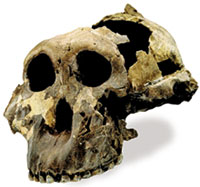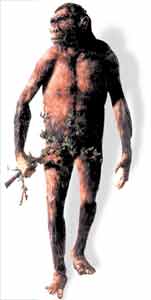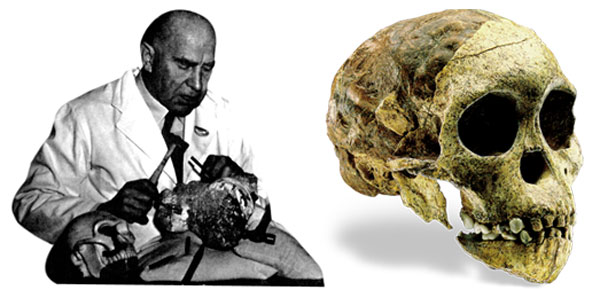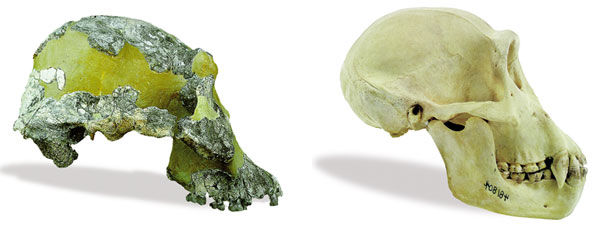Australopithecus
Creatures, named Australopithecus by evolutionists, are actually nothing but an extinct ape species …
 |
A skull fossil of Australopithecus bosei species coded as OH-5 |
  |
Australopithecus means "southern ape". Falling into different categories, all Australopithecus species are extinct apes that resemble the apes of today. Their cranial capacities are the same, or smaller than the chimpanzees of our day. There are projecting parts in their hands and feet which they used to climb trees, just like today's chimpanzees, and their feet have grasping abilities to hold on to the branches. Many characteristics such as the closeness of the eyes, sharp molar teeth, mandibular structure, long arms, short legs, are evidence of these creatures being no different from today's apes.
Evolutionists claim that although the Australopithecus species have the anatomy of an ape, they walked upright like humans.
Extensive research done on various Australopithecus specimens by two world-renowned anatomists from England and the USA, namely, Lord Solly Zuckerman and Prof. Charles Oxnard, has shown that these creatures were not bipedal and had the same sort of movement as today's apes. Having studied the bones of these fossils for a period of 15 years, with funding from the British government, Lord Zuckerman and his team of 5 specialists reached the conclusion – although Zuckerman was an evolutionist himself – that Australopithecines were only an ordinary ape species and were definitely not bipedal.48 Correspondingly, Oxnard, who is also an evolutionist, also likened the skeletal structure of Australopithecus to that of modern orang-utans.49
 |
DART AND HIS CHILD The first Australopithecus fossil was discovered by evolutionist palaeontologist Raymond Dart. The first specimen discovered by Dart was named the "Taung Child". Dart had suggested that this fossil, which belonged to a very young individual, had "human-like" features. Discoveries that were made in the following years, however, showed that the Australopithecus species definitely had an ape's face. |
The detailed analyses conducted by the American anthropologist Holly Smith in 1994 on the teeth of Australopithecus indicated that Australopithecus was an ape species.50
 |
"FAREWELL LUCY!"
Scientific findings countered the evolutionist propositions on "Lucy", the most famous specimen of the Australopithecus species. The well-known French science journal, Science et Vie, admitted this fact in its February 1999 issue with the headline "Farewell Lucy" (Adieu Lucy) and the statement that Australopithecus could not be considered the ancestor of man. |
Within the same year, Fred Spoor, Bernard Wood and Frans Zonneveld, all specialists on anatomy, reached the same conclusion through a totally different method. This method was based on the comparative analysis of the semi-circular canals in the inner ear of humans and apes which provided for sustaining balance. The inner ear canals of all Australopithecus specimens analysed by Spoor, Wood and Zonneveld were the same as those of modern apes.51 This finding once more showed that the Australopithecus species is a species similar to modern apes.
 |
AUSTRALOPITHECUS AND CHIMPANZEE The skull of the Australopithecus aferensis and that of the modern chimpanzee are very similar to each other. This similarity verifies that creatures falling into the Australopithecus classification are an ape species that have nothing to do with humans. IMAGINARY DRAWINGS Such evolutionary drawings depicting Australopithecus walking have been disproved by the latest scientific discoveries. Skull coded as A.L. 444-2 that belongs to the Australopithecus afarensis species Chimpanzee skull |
Footnotes
50) Solly Zuckerman, Beyond The Ivory Tower, New York: Toplinger Publications, 1970, S. 75-94.
51)Charles E. Oxnard, "The Place of Australopithecines in Human Evolution: Grounds for Doubt", Nature, Band 258, S. 389
52) Holly Smith, American Journal of Physical Antropology, Band 94, 1994, S. 307-325.
53) Fred Spoor, Bernard Wood, Frans Zonneveld, "Implication of Early Hominid Labryntine Morphology for Evolution of Human Bipedal Locomotion", Nature, Band 369, 23 Juni 1994, S. 645-648.
- An Outdated View: The Theory of Evolution
- The Origin of Life
- The Design in the Protein
- The Design in the Cell
- Genetic Information
- The Design in Nature
- Miller's Experiment
- The Natural Selection Misconception
- Mutations
- Irreducible Complexity
- Impasse of Intermediate Forms
- The Cambrian Period
- Fish and Amphibians
- Coelacanth Misconception
- Reptiles
- Birds and Reptiles
- Archaeopteryx Misconception
- Bird Feathers
- The Origin of Mammals
- Living Fossils
- The Tale of Man's Evolution
- Australopithecus
- Homo Erectus
- A Lost Human Race: Neanderthals
- The Collapse of the Family Tree
- The Bipedalism Impasse
- False Faces
- Piltdown Scandal
- Why is Evolution Defended?
- The Obvious Truth: Creation
